History of William Morton & Sons - Grocers, Ince and Wigan
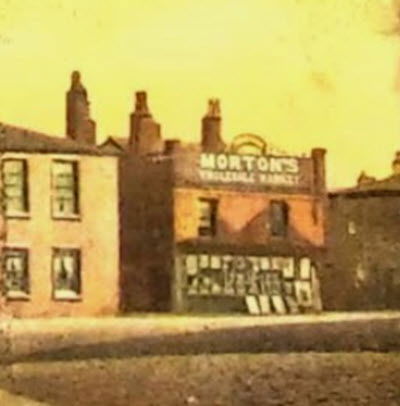
William Morton (“1st”) was born in Billington, near Blackburn on 1 April 1801. His parents were Thomas (who was a weaver) and Alice Morton. Apart from these facts, nothing further has come to light about his background. On 20 September 1826, he married Mary Walmesley at All Saints Church in Wigan. She also hailed from Blackburn, being born there on 14 March 1799.
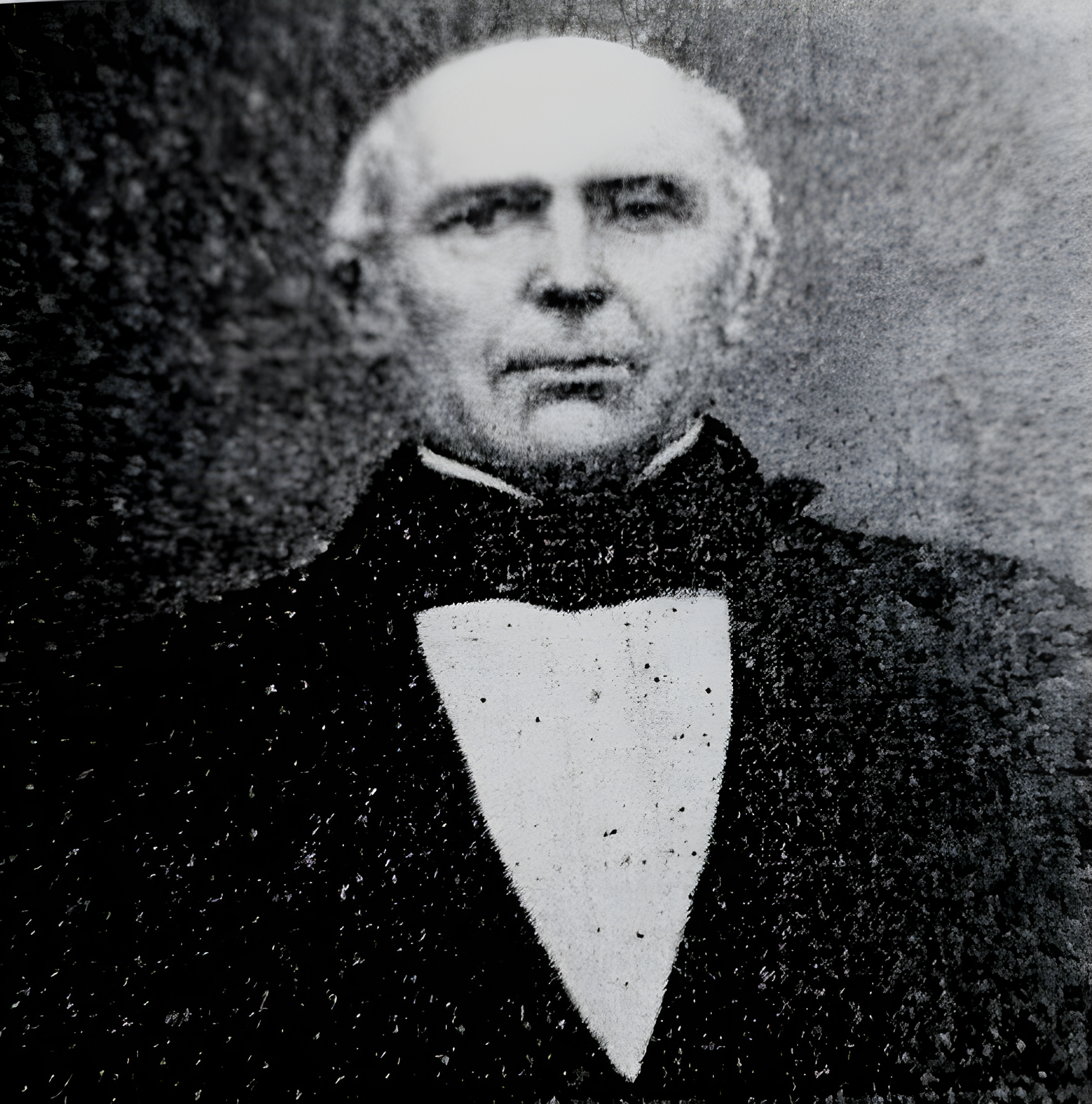 William Morton I - 1801 - 1882
William Morton I - 1801 - 1882
It is not clear as to exactly why they had come to Wigan. In 1838, when registering his son William’s birth, he was unable to write but he gave his occupation as a “weaver”. So it may have been for financial reasons.
The decade between 1835 and 1845 saw the number of power looms more than double (from 109,000 to 225,000) and the number of handloom weavers fall by two-thirds (188,000 to 60,000) with all the attendant human misery. Possibly as a result of this depression in the weaving industry, in 1839 he opened “a small mixed grocery business” in Manchester Road, Ince.
This was to be the forerunner of the later grocery firm. By the time of the 1841 census, he called himself a “shop keeper” with an address in Broom Street, Ince. This remained his trade throughout the rest of his life. Later investigation has found his address to be 32 Manchester Road, on the corner of Broom Street. He was on his way to establishing himself.
 Shop - 1-3, Ince Green Lane
Shop - 1-3, Ince Green Lane
There were four children of the marriage, William (2nd) being the youngest being born on 19 November 1838. He became involved in his father’s business from an early age and was to build up a thriving and extensive family organisation which was to last over one hundred years.
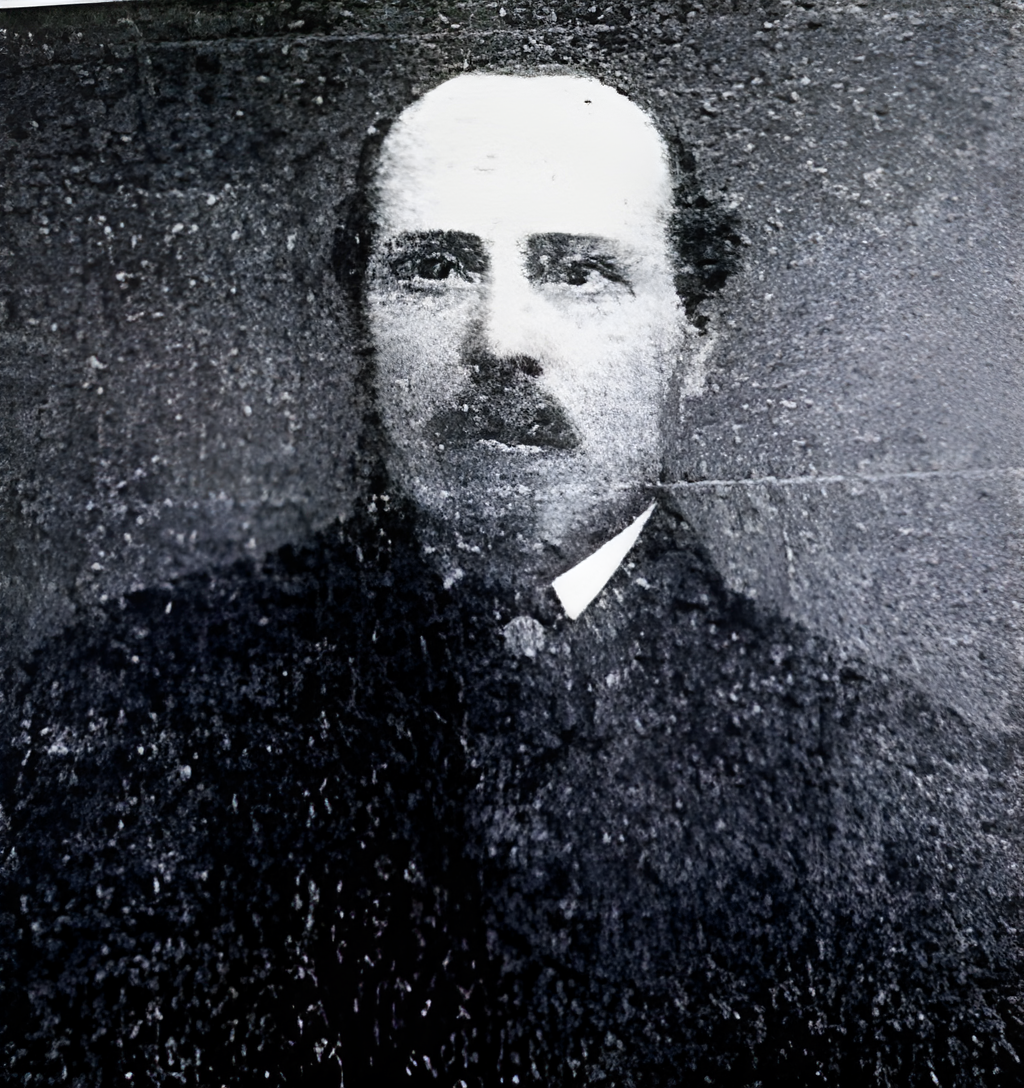 William Morton II - 1837 - 1904
William Morton II - 1837 - 1904
He was to marry a local girl, Ann Boardman, on 10 September 1861. Mary Morton died in 1855. Sometime after their mother’s death, William and his sister Alice moved from their father’s shop and, as partners, opened a grocery business in Manchester Road, Ince. This was in 1858 probably in conjunction with and having financial support from their father marking an expansion of the business.
Following his sister’s marriage, William remained at that address and continued there after his own marriage three months later. Their father (William 1st), who continued to be described as a grocer, and to live at his shop at number 32 Manchester Road, married again on 8 February 1862. His second wife, Martha Barton was a widow. She was born in 1819 or 1820 as Martha Liptrot in Orrell. Her father was a famer and also a provision dealer.
Meanwhile William (2nd) was expanding his business as well as fathering a large family. Ten children were born in the seventeen years between 1863 and 1880. William Richard was born in 1863 but died at the age of 3 years in October 1866; Minnie was born in 1866; William (3rd) in 1867; Margaret Alice (1st ) in 1868 but died on 20 October that year aged only four months; Walter Herbert in 1869; Noble in 1872; Frederick Richard in 1874; Margaret Alice (2nd) in 1876; Annie Mary Florence in 1877; and finally Ernest Harold in 1880. All the male children were destined to join the grocery business.
The 1869 Directory for the area gives the address of “William Morton, jun.” as Smithy Green where he is described as a “Grocer and provision dealer”. William Morton (1st )was described in the same directory as a grocer living in Manchester Road where he continued to live for the rest of his life.
On 7 March 1882 Martha died, aged 62 and William was to follow shortly after on 13 April. He was 81years old. It is not clear what commercial arrangements existed, if any, between him and his son, but the family always considered 1839 as being the founding year of the firm. As such it was printed on their letter headings and other business documents.
Later that year there was further grief for the family with the untimely death of Ann Morton on 8 November 1882. She was only 44 years old, with four of her surviving children under ten years. William re-married however on 4 September 1883. His second wife was Mary Lyon, a spinster, and also a provision dealer working with her brother John and sister Agnes from premises at Latham’s Yard off Millgate in Wigan. She was born in Abram in 1843, the first of eight children born to Edward and Isabella Lyon.
He too was a provision dealer and grocer and a baker, initially with premises in Millgate, then Dorning Street and eventually in Dicconson Street, all within Wigan Borough. By 1889 the business had expanded considerably, with three branch shops, and William, who was still the sole proprietor, was able to style himself as “Wholesale and Retail Grocer and Provision Merchant, Dealer in Foreign Wines, Malt, Hops, Vinegar, etc., and Brewer”.
The premises at 124-128 Manchester Road became the main warehouse and stores. A contemporary trade journal’s description of the business was given as follows:-
“The firm’s headquarters consists of a handsome warehouse, with spacious stores in the rear. The wholesale stores occupy two spacious floors, that on theground flat being devoted to storing preserves – of which there is an immense stock – grinding coffee, and cleaning currants and other dried fruits by new patent machinery. The flat above is divided into three large compartments, one being used for storing flour; another for provender, comprising corn, beans, peas, Indian corn, and everything in the nature of cattle-feeding stuffs; and the third floor for warehousing tea, coffees, sugar and other groceries. The establishment is equipped with one of the most approved tea-mixing machines, which is kept constantly busy in preparing the celebrated teas of the firm, now so much prized by all classes for quality and price. The front warehouse or sales hop, like the branches at 48, Manchester Road; 178, Belle Green Lane; and370, Warrington Road, is most tastefully fitted up and arranged, and displays to advantage the splendid stock of goods for which the firm’s establishments are so popular amongst the householders. These include, besides every description of groceries and provisions, all kinds of foreign wines, malt, hops, vinegar, ales and porters. In addition to the departments named as being situated in Manchester Road, the house has a thoroughly-equipped bakery, a large room where the bacon and hams are dried, a coffee-roasting establishment, and a fine stable and van-shed. The trade of the firm is both wholesale and retail, and requires the service of eighteen hands.”
The writer of this laudatory and lavish description about the business of “this enterprising proprietor and extensive concern” then goes on to examine the nature of the firm’s customers by looking at “the secrets by which this house has won the confidence of the rich and the poor, the middle classes, and those between them and the rich and the poor, are their being able to buy from the foremost producers for cash, and preferring to make twenty sales for one profit than one sale with ten profits, sparing no expense in machinery and appliances for purifying goods, and treating others, such as coffee and tea, on their own premises rather than risk its being adulterated by buying these in their mixed and prepared state”.
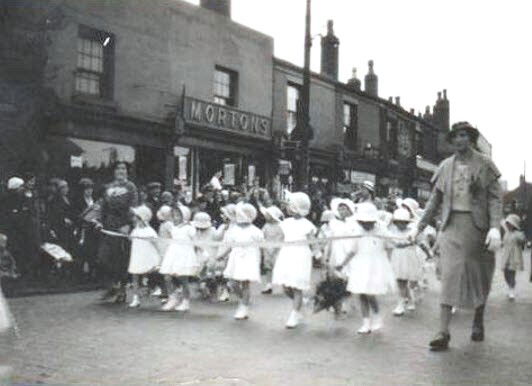 Belle Green Lane Shop
Belle Green Lane Shop
When this was written William was aged fifty, but was showing no signs of resting on his laurels. He was also a member of the Ince Local Board and School Board and shortly before this article above was written had taken ownership of a brewery known as Winstanley’s situated in Pickup Street in Ince.
It was natural that his sons would enter the expanding business on reaching school leaving age. William Edwin, the eldest, became a shop assistant at the main shop in 1881 and by 1891 was the manager of the brewery.
One by one his other brothers became “assistant grocers” in the firm with Walter Herbert joining in 1883; Noble in 1886; Frederick Richard in 1888; and the youngest, Ernest Harold in 1894. To make room for the warehouse premises at 114 – 118 Manchester Road it had been necessary to vacate the living accommodation there.
William and Mary with William’s four youngest children moved to 212 Ince Green Lane. There were no children of the second marriage. William (3rd ), Walter and Noble moved into 124 - 128 Manchester Road, where Minnie, the eldest, acted as housekeeper.
In the 1891 census she was aged 25 and William “Willie” was 24 and a brewer, whilst Walter (21) and Noble (18) were described as Assistant Grocers. Minnie’s role as house keeper to her brothers was short lived as she married George Baldwin later that yea rand moved to Brookhouse Street in Wigan.
In 1896 further tragedy struck. On the evening of 30 September, William Edwin Morton, “the eldest son of Mr William Morton, brewer and provision merchant”, who was then aged 29 and a member of the Wigan Rowing Club, which was based on the Leeds and Liverpool Canal at the former coal loading basin at Haigh, was drowned when returning in a boat from Arley Hall Farm.
The boat was rowed by a lady friend, Alice Eastwood, and the couple had been having tea at the farm with friends and were returning home at dusk. William was taking the tiller. As they approached Pendlebury Bridge in fading light, it was said they heard a voice shout “heigh up” as if “there was a barge coming”, having passed two barges previously quite safely.
This was followed by noise sounding like “the rope of a barge being pulled over” the bridge. To avoid it William took hold of one of the oars which caught in a crevice in the stonework of the bridge causing the boat to be “thrown broadsides” resulting in William being “thrown into the water”. The boat quickly filled with water and Miss Eastwood was also flung into the canal. William then surfaced and told her to cling to the boat.
Their shouts for help were heard by people from nearby cottages, and two men from there rushed to help. Both had sunk by the time they arrived, although Miss Eastwood was still clutching the boat which was now upside down. They managed to get her to the bank but there was no sign of William, who was wearing a heavy overcoat. It was an hour before they could recover his body with the aid of grappling irons brought from a nearby farm.
An inquest recorded accidental death. The boys who alerted the rescuers denied issuing any warning of an approaching barge. At the time of his death William had been working as a “traveller” for his father’s firm.
His brothers Walter “Brewer’s Traveller” and Noble “Grocer - own account” married in 1897 and 1898 respectively both moving to addresses in Ince. In the years before the turn of the century, the business continued to develop with several shops being opened in different parts of the district, and with off-licenses being added to some of the branch shops as well.
New shops in this period were at 162 Manchester Road, where Noble Morton was in charge; at 1-3 Ince Green Lane in Ince; and at 99 Chapel Lane in Wigan. The latter was the firm’s first venture into the Borough. By this time William had moved to Southport, probably as a result of his wife’s failing health, since she died thereon 17 January 1900. She was 57 years old.
They had been accompanied there by his daughter, Annie, who continued to live with her father. His sister Alice Charnock, also widowed came to live nearby. Meanwhile the two younger brothers Frederick Richard and Ernest Harold moved into the shop premises at 124, Manchester Road, along with their sister Margaret, who acted as the housekeeper.
Early in 1901 a decision was made to form a limited company under the title “WILLIAM MORTON & SONS LTD”. The Memorandum and Articles of Association were issued and the company was incorporated on 26 June 1901. The capital was £20,000 made up of 1600 preference shares and 2,400ordinary shares, all of £5 each.
The subscribers were William Morton; his sons Walter Herbert, Noble and Frederick; Minnie Baldwin; Margaret Alice Latham; and Annie Mary Florence Morton. The three sons, Walter, Noble and Frederick, joined their father as directors. Charles Henry Parsons was appointed secretary. The youngest son Ernest Harold joined a short time later following his 21st. birthday on the 12th July.
In the same year the first of the firm’s annual trips was inaugurated for employees and customers. This was to Whittle Springs in horse-drawn “waggonettes”. Following the success of this venture an annual trip was made to Blackpool, proving to be extremely popular and jolly, with some 1800 customers joining the trip on one occasion. In later years other venues included London and Belfast, along with other places in Northern Ireland.
William Morton (2nd) died on 26 December 1904 aged 67 in Southport and an obituary appeared in the Wigan Observer on 31 December 1904. He was described therein as “well known” and of a “genial disposition”. It then went on to say “For some years he was a member of the Local Board and whilst acting as such attended regularly and took considerable interest in the affairs of the township. In politics he was a Liberal but seldom took a prominent position in Liberal matters. For many years when resident in Ince he was an active member of the Parish Church congregation and assisted all the various church organisations”. He was buried at Ince cemetery, alongside his two wives.
Following his death, Ernest Harold, the youngest brother was appointed as a director, taking responsibility for the brewing side of the company’s operations.
Business continued to flourish over the decade following William’s death, with ten new branches being opened over this period. Most were in Wigan at 66, Wigan Lane; 118, Wallgate; 196, Darlington Street East; 47, Greenough Street; 18,Vauxhall Road; and 3, Gidlow Lane; with others at 85, Ormskirk Road, Pemberton; 88, Walthew Lane, Platt Bridge (where for a time Walter Herbert Morton resided as grocer and brewer); 12, Orrell Road, Lamberhead Green; and 395, Warrington Road, Goose Green.
 Shop - Walthew Lane, Platt Bridge.
Shop - Walthew Lane, Platt Bridge.
As a result the existing storage facilities in Manchester Road became inadequate and in 1913 the building of a much more extensive warehouse and bake house was commenced on a vacant plot of land on Lord Street and Pickup Street in Ince. The premises were completed just before the First World War. The company’s registered office was also based there.
 The Warehouse
The Warehouse
Like all businesses the war created great difficulties for the firm. A total of thirty eight members of staff joined the forces and most shops were run by a "skeleton staffs of girls”. Shortage of staff resulted in two shops closing down and rationing was also imposed.
Following the cessation of hostilities trade gradually started to revive again despite the difficult economic situation in the years that followed. Besides the greater storage space at the new warehouse, bread was baked in the modern bakery there and marketed under the slogan “Better than any, cheaper than many”. Other facilities included coffee roasting equipment; tea packing; and a refrigerator along with “cool cellars”.
An extraordinary meeting of the company on 23 September 1920, authorised a further allocation of ordinary and preference shares amongst the family.
Over the next few years further branches were opened in the wider Wigan area. The first was at Hindley where the premises at 137, Market Street were purchased in 1923. The building was formerly the White Horse Inn. Other branches opened later at Bryn (Wigan Road/Bryn Road) and then in Standish (High Street).
 Florrie Wright - Market Street Shop, Hindley
Florrie Wright - Market Street Shop, Hindley
As the economic depression became worse after the Wall Street crash at the end of October 1929, it was decided to sell off the brewery side of the business in 1931. This was a time of many amalgamations and take-overs in British industry. It was acquired by Messrs. Cunningham, brewers and bottlers from Warrington. Brewing ceased at the brewery in Pickup Street and the property was converted to dwelling houses with part being rented to Ince Social Services Club at a “nominal rent”.
A further shop was built, followingthe sale, at 88, Whelley in Wigan. The building was in the art-decor style and was built by Pyke Brothers, and opened on 8 February 1932. This shop is still standing having changed hands a number of times, operating as an ice cream parlour and cafe early in 2019 and currently as a barber’s shop.
Another development at this time was the opening of a gift shop in Hallgate in the town centre in 1933. This followed the introduction some years earlier of their “Saayune” coupon products. These were brands of various commodities that contained gift coupons and which could be exchanged for the company’s special free trips in summer and for turkeys, geese and parcels of groceries at Christmas.
 Shop - Junction of Manley St. & Ince Green Lane, Lower Ince (workmen laying electric cables)
Shop - Junction of Manley St. & Ince Green Lane, Lower Ince (workmen laying electric cables)
The products were labelled as to “defy comparison for quality and price!” They included tea, coffee and cocoa; soap; self-raising flour; salt; marrowfat peas; jellies; evaporated milk; custard powders; margarine; baking powder; full cream milk; and meat and fish pastes. Additionally any empty jam jars returned bearing Morton’s labels for their “Pure New Season’s Jams” attracted coupons at one full coupon per two pound jar and one half coupon for a one pound jar! This was re-cycling with an incentive! The scheme was now extended to “wonderful gifts” for coupons exchanged at their gift shop.
Again the list of gifts available was extensive, with cleaning and washing requirements; cooking utensils; women’s and girl’s wear; men and boy’s wear (these included “boy’s tweed knickers” which must have proved uncomfortable!); blankets and bedding; household linen and curtains; mats and carpets; boots and shoes (but no clogs!); crockery; cutlery; and a variety of other items ranging from wash leathers to watering cans and vacuum flasks to vases.
Ernest Harold Morton, the youngest son, died on 14 February 1935 after a long illness at the early age of 55. At the time of his death he resided at “Belmont”, Wigan Lane having moved to the Wigan area some twenty two years previously. He had principally been involved with the brewery until its sale. He was replaced by Walter’s eldest son William.
As the depression eased another shop was opened in 1938 at Beech Hill. This was in an area where Wigan Corporation was in the process of building a large housing estate in the north of the borough on what was previously farming land. Like the earlier shop at Whelley, it was built in art-decor style, again by the Pyke Brothers.
The centenary of the company was celebrated the following year, 1939.By now the business was packaging its own bacon, smoked bacon and gammon imported from Ireland and Denmark twice weekly and butter also from Denmark, as well as Lancashire cheese.
There were twenty five branch shops as well as a stall in Wigan Market and the gift shop in Hallgate. Other family members were by this time were involved with the day to day operations. Walter Herbert, the oldest surviving son, who had by now completed 55 years of service with the firm remained as a director but was approaching seventy in that year.
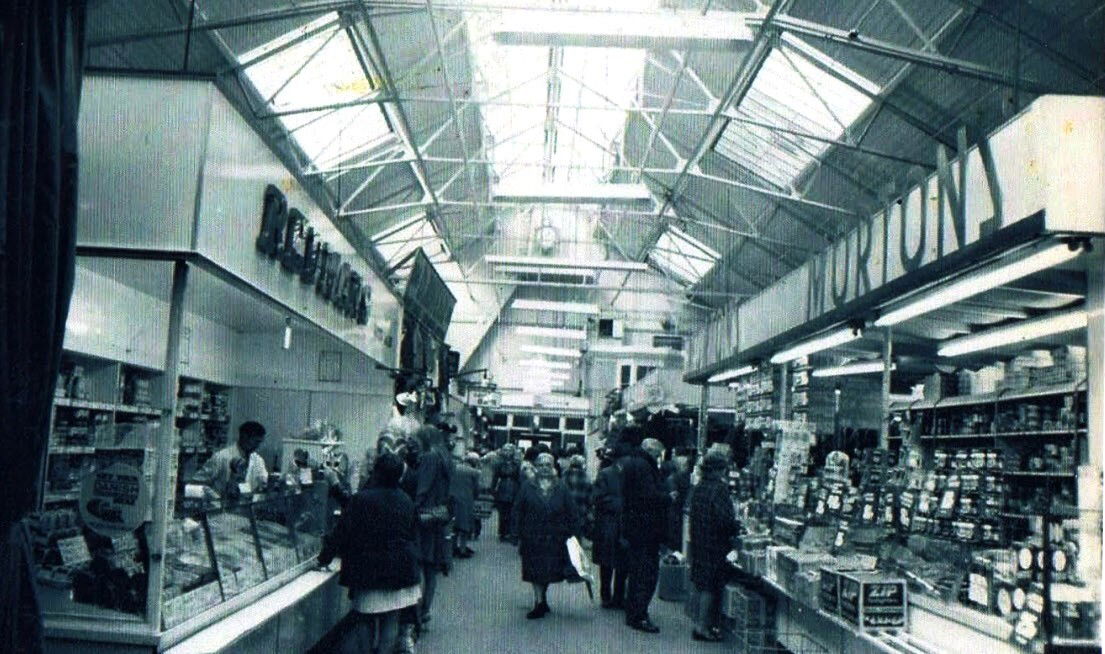 Stall - Wigan Market Hall
Stall - Wigan Market Hall
However his elder son, also called William (4th),who had replaced Ernest Harold in 1835 was now the Managing Director of the “Multiple & Store and Food Distributors”, having been in the business for 25 years.
Walter’s younger son also named Walter Herbert was the warehouse and bakery manager. Noble and Frederick, with 53 years and 51 years service respectively, also remained as directors.
Noble’s two sons Norman (born 23 June 1900) and Harold (born 9 May 1903) were employed as a supervisor for the retail section and as a grocer’s clerk respectively. Frederick’s surviving son Frederick William(born 24 July 1908) worked as a warehouse man in the business. His other son Sydney had died in a road traffic accident in 1923 when he was only 11 years old. Ernest Heaton Morton (born 1913), the only son of Ernest Harold, was assistant warehouse manager.
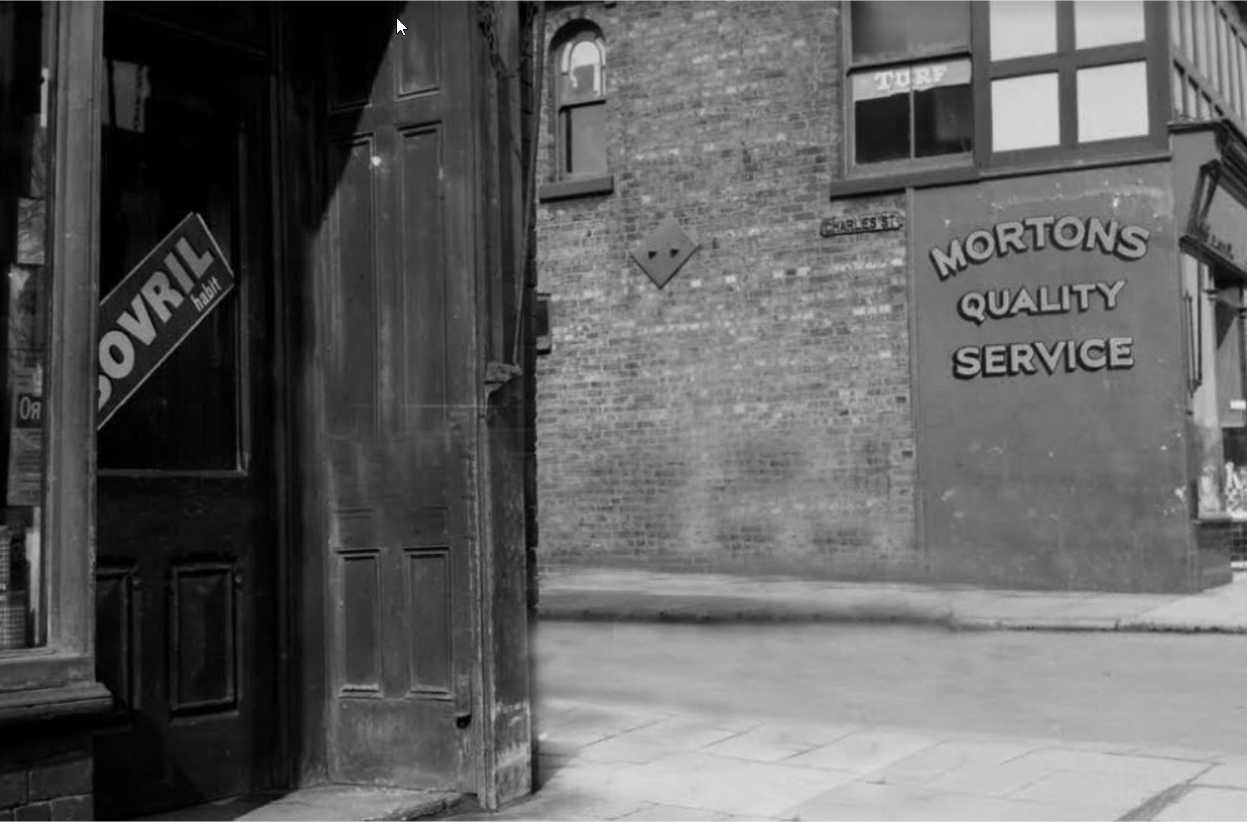 Shop - Junction of Charles St. & Wigan Lane.
Shop - Junction of Charles St. & Wigan Lane.
The outbreak of war again affected business significantly. Ernest Harold joined the army. Whilst staff shortages appeared not to be as severe and to the same extent as in the previous conflict, the main problem was the availability of food. Sugar was in short supply, Danish bacon, ham and butter obviously were no longer available, supplies of coffee and tea were greatly curtailed as were other day to day provisions. Bananas were non-existent throughout the war along with foreign cheeses and other overseas imports.
The government strictly controlled food supplies and introduced rationing for the vast majority of foodstuffs, by the issuing of ration coupons. The Saayune coupon system ceased to operate. These restrictions were to operate for several years after the war ended.
Two of the original directors died during the course of the war. Walter Herbert Morton senior died in January 1943. He was aged 73. On 22October in the same year, Frederick Richard died at the age of 69. The only male survivor then was Noble who died on 5 October 1948, aged 76. In addition to William Morton (4th) who had become a director in 1935 following the death of Ernest Harold Morton, other grandsons including William Herbert(junior,) the younger son of William Herbert (senior), and Norman, the elder son of Noble, were admitted as directors. Later Harold, Noble’s younger son and Ernest Heaton Morton, the only son of Ernest Harold were also to become directors.
Following the end of the war, despite continuing austerity measures, attempts were made to return to normality. Even the annual trips were resumed for a few years. There had been no expansion of the business during the ensuing war years. However in the early 1950s, a twenty sixth branch was added, when in the Wigan town centre a new store was opened in Hallgate.
Described as “frankly experimental” this was a self service shop. Such stores had been operating in London and other southern towns for some years, following the first fully self service food store which had been opened by the Co-operative Society in March 1948 in Southsea, Portsmouth.
There had been reluctance to this type of outlet in the north where the spirit of “grocers with tradition” was still strong. The venture therefore was something of a pioneering project. The shop was small measuring just 18 feet by 38 feet. It had previously been a draper’s shop.
It commenced business in April 1952. The description of the shop at the time stated that “simplicity is the essence of the layout” and consisted of three straight lines of shelving with a checkout counter in the front left corner where the “itemising and totalling cash register” was installed.
This method of retailing is all too familiar today but in Wigan at the time, where “changes were made with caution”, it was a radical innovation. Nevertheless in the first weeks after opening there was considerable success, with a turnover which was “fifty per cent more than it would have been under counter service”. Both the opinions of customers and staff were favourable. It was staffed by a manager and three assistants and remained open at lunch time, another innovation and a particularly useful one in the town centre.
A contemporary report, reflecting the new attitudes following the austerity immediately after the war concluded that “as in other self-service shops, there has been a steep rise in sales of such lines as varnish, polishes, bath cubes and shampoos”!
Later in that decade another conventional shop, the twenty seventh, was opened at Shevington in a row of shops in the centre of what had been a small mining village but where some new residential building was being undertaken. The exact date is not certain, this proved to be the final expansion of the business. Times were changing.
From then on the firm’s financial situation started to deteriorate. No more self service shops were opened, although in other parts of the country this trend continued to increase.
The first supermarket, as is familiar today, opened in the USA as early as 1930 and in 1951 the first British supermarket opened in Streatham, South London. These premises were extensive and were able to display a vast amount of products. This enabled their ability therefore to purchase goods at lower prices by way of economy of scale and thus to sell on at lower prices than the smaller shops. Accordingly these stores were also able to offer more choice.
Furthermore, car parks were often attached to the stores, altering methods of shopping even more, particularly so as car ownership increased. By the end of decade these establishments had spread to the north of England. The writing was now on the wall for local counter selling grocery shops.
The customers of many of Morton’s shops had lived nearby and by this time many of them were being re-housed as the adjoining houses were demolished. Another reason for the firm’s declining position was that younger members of the family were not entering the business.
The result was an extraordinary meeting on 28 November 1958 when the company faced financial difficulties. This prompted the directors at the time to sell the concern. The business was marketed as having twenty eight branches (which included the gift shop) all but one were said to be “counter served”. Between September 1960 and March 1961 negotiations with Cooper and Company’s Stores, a Liverpool firm, were carried out but no deal was reached. At this stage Wrights Biscuits, a firm from the North East of England, stepped in and by the end of the year a price and terms had been agreed for the sale to them. The sale was completed on 9 January 1962.